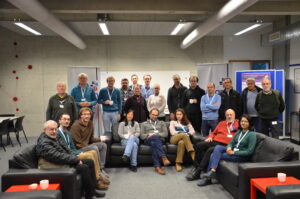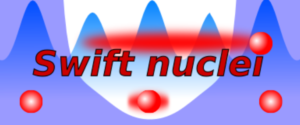
During 7-9 December 2022 the workshop on quantum dissipation by swift nuclei took place in Lausanne, at the CECAM headquarters. It was jointly funded by CECAM , Psi-k, and the Lawrence Livermore National Laboratory. It brought together key people in the fields of electronic stopping of nuclei in matter, non-adiabatic quantum dynamics, and density-functional theory and many-electron dynamics, to face the problem of quantum dissipation of swift nuclei in matter, from quantum friction effects of ions/molecules on surfaces and nanoconfined flow, to strong dissipation under irradiation. Invited speakers were prompted to talk about their recent work and ideas in their own topics which they thought could connect to the other subfields. The general ambition was cross-fertilisation,and exploring how connections of advances in one field might contribute to the others. In the spirit of traditional Psi-k / CECAM workshops, ample opportunity for discussion and lateral collective thinking was provided.
Full details can be found in the CECAM web page for this event.
The format consisted of three full days, including seven talks and a discussion session per day, after the afternoon coffee break. Slots of 40 min were allocated per speaker, aiming at 20-25 min of lecture and 15-20 min of discussion. Most of the talks were delivered in-person, The workshop was structured in three interconnected themes, one per day, starting with nuclei as projectiles (experiment, theory, simulation), followed by levels of theory for the dynamics of the electronic subsystem, to conclude with quantum coupled dynamics of electrons and nuclei, including connection to other non-adiabatic contexts. Each day had an associated discussion session led by one of the participants who identified important open questions to be addressed in the future, as arising from the presentations.
Key needs identified and actions proposed to address them can be summarised as follows:
- Promoting further interactions between modelers and experimentalists and ensuring that experimentalists’ input on relevant questions and coherence between models and experimental set up is clearly disseminated. To foster this goal, the organization of a follow-up workshop driven by experimentalists was proposed and will be pursued for 2024.
- Clarifying and disseminating state-of-the-art and open questions via a shared publication in the form of a roadmap paper. In particular, this work should include a more important participation by the cognate community of non-adiabatic dynamics applied to chemical processes, which has developed a number of quite advanced tools, especially in the field of photochemistry.
- Identify challenges and benchmark systems for currently existing techniques. In particular, an adequate description of electron thermalisation after a strong energy pulse was considered a timely and suitable challenge for the dynamical simulation techniques being used (such as TDDFT).
Concluding:
It was considered a quite successful meeting by all, deserving further exploration.
Organisers:
- Emilio Artacho (Nanogune, DIPC, Ikerbasque, U. Cambridge),
- Sara Bonella (CECAM, EPFL),
- Alfredo Correa (Larence Livermore National Lab)
- Jorge Kohanoff (U Complutense, Madrid)

